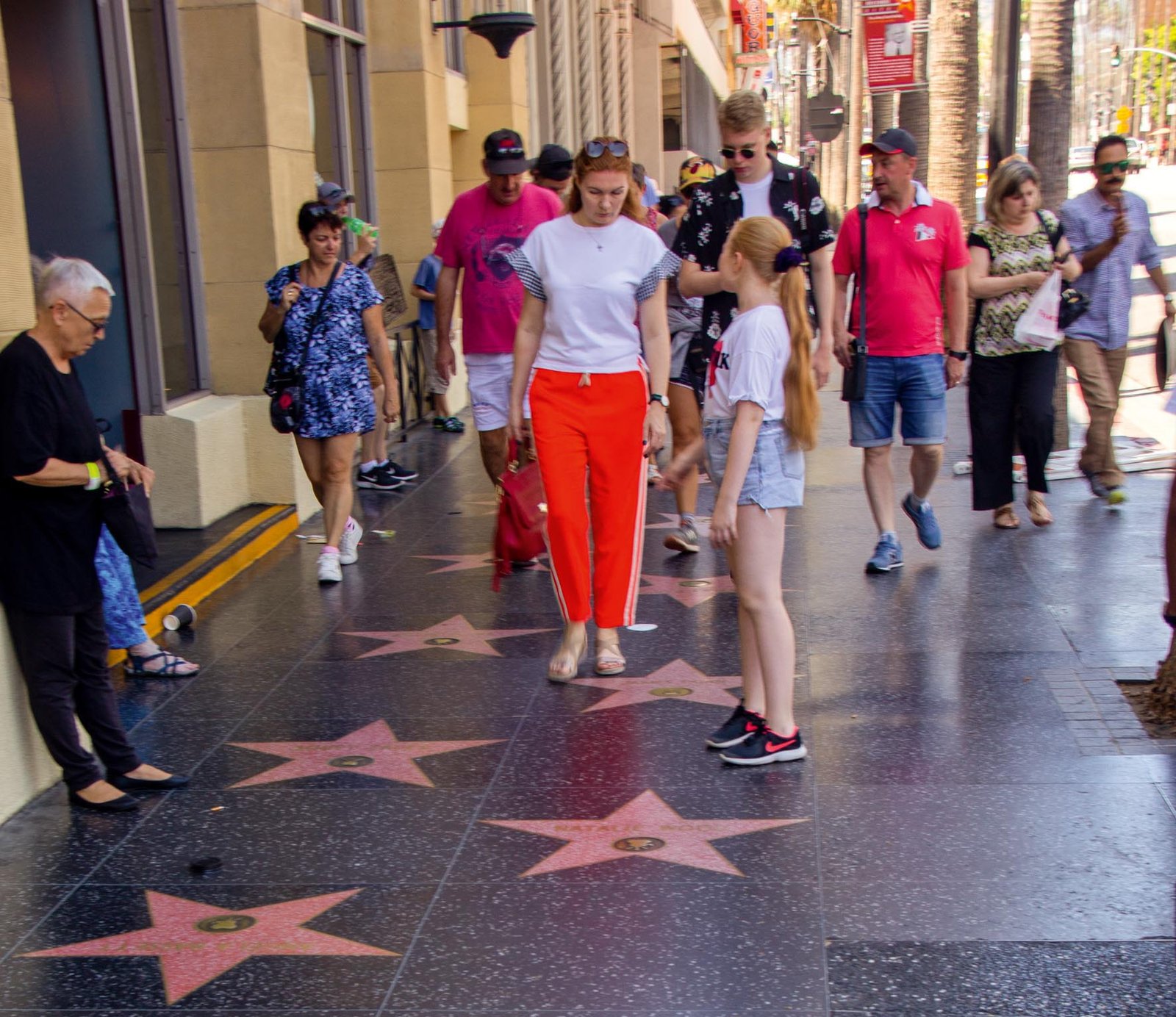
Boulevard of the Stars
By Julia Henríquez
Photos: Demian Colman
It was early. Still feeling groggy, we disembarked from our transport and embraced the city as it awakened. People began streaming in from all sides; some set up street stalls for the day’s business. Everything looked ordinary, but my heart was pounding: at long last, I found myself in the heart of Hollywood, on the boulevard that encapsulates the truth, lies, parody, and metaphor of the world’s most influential movie industry.
We turned first toward the Dolby Theatre, home of the Oscars; the televised ceremony continues to fascinate movie fans from around the world. We slowly and elegantly sauntered up the red steps we had seen so many times on television, but at the top, we could only press our faces against the glass doors and peer in, trying to discern what was happening inside. American Idol auditions are also held at the Theatre, so it is busy most of the time; getting inside is a matter of luck and luck wasn’t with us this time.
We sipped coffee and returned to the real world, which had already changed, just as if it were a Hollywood set. The sidewalks were bustling with people. Strolling tourists gawked amidst super heroes and musicians. The brief expanse offered us the chance to drive a luxury car, put our names on a star, save ourselves from the Apocalypse by joining a church whose name I can’t remember, and even take part in a marijuana tasting. This is indeed magical realism. How does such a busy and chaotic street look so good for the world’s cameras? To help orient ourselves in time and space, we joined the Hollywood Behind-the Scenes tour at the entrance to the Hard Rock Cafe.

I learn that we can’t talk about Hollywood without talking about Sid Grauman. Sid and his father David came to Los Angeles during the Jazz Age, hoping to give movies the same cultural cachet as opera. He was sure that film represented the future and that the glamour of the stage would translate to the big screen. To bring their vision to life, they built the Egyptian Theatre to create a stage design that would draw spectators into a venue as epic as history itself. The world’s first red-carpet event, the 1922 premiere of Robin Hood, took place among sphinxes and life-size figures. The unprecedented success of that showing still echoes inside the hieroglyph-patterned walls of the building that currently houses the Los Angeles Cinema. But that was just the beginning. Grauman would continue to promote film culture with the cinemas The Million Dollar Theater, in the city’s administrative district; El Capitán, now owned by Disney; and Grauman’s Chinese Theatre. The last two theaters face each other amid the chaos of Hollywood Boulevard.
The Chinese Theatre is fronted by a red entry that sits under an angled green-tile roof, guarded by dragons. It’s every dream of China rolled into one. The beauty of the theater, both inside and out, and Grauman’s obsession with glamorous premieres, turned the site into the official home of the red carpet.
Every since the theater opened in 1927, people have cherished the hope of meeting a TV or film star at a premiere. However, the grand premieres and red-carpet events are not the theater’s main attractions. After hosting the very first Oscars awards ceremony, the theater adopted the custom of preserving the hand and footprints of the stars. Theater co-owners Mary Pickford and Douglas Fairbanks were the first stars to leave their prints in wet cement in front of the Chinese Theatre. More than two hundred names have been immortalized, including those of animals and even robots from galaxies far far away. The theater offers a guided tour and a mini-documentary about its history but most visitors are more interested in seeking out the hand and footprints of their favorite star so they can take a selfie and immediately post it on social media.
The epicenter of film covers a scant two blocks of Hollywood Boulevard, but it could take days to visit all the attractions. The tour serves up a rich medley of information that is best processed little by little.

The guide reveals the secrets hidden behind the façades on each corner: “On that corner, the apartment where Richard Gere told Julia Roberts he loved her in the film Pretty Woman; over there, the Hollywood Museum and Madame Tussauds; farther along, the Selfie Museum and Ripley’s Believe It or Not, where Jimmy Kimmel Live! is filmed. Now we are standing in front of the Hollywood Roosevelt Hotel, where stars like Marilyn Monroe and Charles Chaplin stayed. And, of course, don’t forget to look down: we are on the amazing Walk of Fame, recently used by Quentin Tarantino in his latest film.”
This is where we need to go back in time. Following the devastation of World War I, the world had a brief period of tranquility and the entertainment industry was there to entertain. Hollywood entered a Golden Age, thanks to the efforts of thousands of people who devoted their lives to the world of entertainment, helped by a new studio production system that managed its luminous stars.
Years later, with the industry well established, it seemed the right time to honor those who left their mark on the world of U.S. entertainment. In 1953, E. M. Stuart, president of the Hollywood Chamber of Commerce, had the idea of creating a public thoroughfare to honor the community that had endeared itself to the entire world. The honor of the first star went to film director and producer Stanley Kramer in 1960.

The Hollywood Chamber of Commerce then established a process for deciding who would be granted a star on the Walk of Fame. Our guide described some of the qualifications for honorees in any of the five categories (music, radio, television, theater, and film). In addition to being an important cultural landmark in Los Angeles, the thoroughfare is one of its most popular tourist attractions. Even though more than 2,600 stars have been added to the 1.3-mile stretch of the Walk of Fame, there is still room for many more.
Our feet are swollen, the sun blazes down, and our bodies beg for a rest, but we want to keep going. We head back to the Dolby’s shopping center and stand on a little bridge to snap a photo of the enormous letters that announce that this is only the beginning. Hollywood still feels out of reach and rather like a leviathan out to devour us, but we are ready to enjoy the journey, confident that we will prevail.



